#Greco-phoenician
Text
Italy Superior and Ancient Rome
Italy Superior and Ancient Rome
Italy Superior and ancient Rome is a necessary post to explain the Venetian (Italian) influence of Florida, formally, called La floridas, which means the land of the flowers.
The Venetians are named after their city Venice, Italy, which is a city built around water with a serious of water canals. Likewise, Florida is a state with thousands of water canals similar to the ones in Venice, Italy.…

View On WordPress
#Ancient Rome#Atlantis#Greco-Roman Architecture#Italy Superior#Kapok Tree Inn#La floridas#Marzocco lion#Mayans#Medici lions#Naga-Maya#Phoenicians#Sam Ash Music Store#Tartarians#Teotihuacan#Venetians#Whitehall in West Palm Beach
13 notes
·
View notes
Text
About Tanit
I recently posted about how people should be looking more into other gods outside of the Greco-Roman pantheons. If you follow me for quite some times, you will also have noted I posted a bunch of loose translation from the French Dictionary of literary myths (which is truly a great reference). Well, I wanted to share with you today a loose translation – well, more of an info-mining at this point – of an article about a goddess that people often ignore the existence of, despite being located right next to Ancient Greece and Rome, and being involved in the history of the Roman Empire. And this goddess is Tanit.
Written by Ildiko Lorinszky, the article is organized in two – at first it takes a look and analysis at the mythological Tanit, at who and what she likely was, how her cult was organized all that. The second part, since it is a Dictionary of LITERARY myths, takes a look at the most prominent and famous depiction of Tanit in French literature – that is to say Flaubert’s famous Salammbô. (If you recalled, a long time ago I posted about how a journalist theorized in an article how Flaubert’s Salammbô was basically an “epic fantasy” novel a la Moorcock or Tolkien long before “fantasy” was even a genre)
Part 1: Tanit in mythology and archeology
Tanit was the patron-goddess of the city of Carthage. Considered to be one of the avatars o the Phoenician goddess Astarte, Tanit’s title, as found on several Punic engravings, was “The Face of Baal” – a qualification very close to how Astarte was called in Sidon and Ugarit “The Name of Baal”. These titles seem to indicate that these two goddesses acted as mediators or intermediaries between humanity and Baal.
Tanit is as such associated with Baal, the vegetation god, but sometimes she is his wife, other times she is simply his paredra (companion/female counterpart). She seems to be the female power accompanying the personification of masculinity that is Baal, and as such their relationship can evoke the one between Isis and Osiris: the youthful sap of the lunar goddess regularly regenerates the power of the god. This “nursing” or “nourishing” function of Tanit seems to have been highlighted by the title she received during the Roman era: the Ops, or the Nutrix, the “Nurse of Saturn”. Goddess of the strengthened earth, Tanit is deeply tied to agrarian rituals: her hierogamy with Baal reproduces in heaven the birth of seeds on earth. Within the sanctuaries of Tanit, men and women devoted to the goddess practiced a sacred prostitution in order to favorize the fecundity of nature. The women tied to the temple were called “nubile girls”, while the men working there were called “dogs” to highlight how completely enslaved they were to the goddess. We know that the prostitutes of both sexes brought important incomes to the temple/
The etymology of Tanit (whose name can also be called Tannit or Tinnit) is obscure. The most probable hypothesis is that the Phoenico-Punic theonym “Tnt” is tied to the verb “tny”, which was used in the Bible to mean “lamenting”, “wailing”, “crying”. According to this interpretation, the “tannît” is originally a “crier”, a “wailer”, and the full name of Tanit means “She who cries before Baal”. As such, the Carthaginian goddess might come from a same tradition as the “Venus lugens”.
According to some mythographers, Tanit (or Astarte) was the supreme goddess of Carthage, and might have been identical to the figures of Dido and Elissa. As in, Dido was in truth the celestial goddess, considered as the founder of the city and its first queen. According to this hypothesis, the suicide of Dido on a pyre was a pure invention of Virgil, who took this motif from various celebrations hosted at Carthage. During these feasts-days, images and depictions of the goddess were burned The word Anna would simply mean “clement”, “mild”, “merciful” – the famous Anna, sister of Dido, is thought to have been another Punic goddess, whose cult was brought from Carthage to Rome, and who there was confused with the roman Anna Perenna, a goddess similar to Venus. Varro claimed that it was not Dido that burned on the pyre, but Anna, and according to this angle, Anna appears as a double of Dido – and like her, she would be another manifestation of the goddess Tanit. Anna’s very name reminds of the name “Nanaia”/”Aine”, which was a title given to Mylitta, yet another manifestation of Tanit.
The sign known as the “sign” or “symbol of Tanit” seems to be a simplified depiction of the goddess with her arms open: it is a triangle (reduced to a trapezoid as the top of the triangle is cut) with an horizontal line at its top, an a disc above the horizontal line. This symbol appears throughout the Punic world on monuments, steles, ceramics and clay figurines.
Part 2: The literary Tanit of Flaubert
Gustave Flaubert’s novel Salammbô is probably where the goddess reappears with the most splendor in literature. While her essence is shown being omnipresent throughout the Punic world, Tanit, as the soul of the city, truly dwells within the town’s sanctuary, which keeps her sacred cloak. The veil of the goddess, desired by many, stolen then regained throughout the plot, plays a key role within the structure of this very enigmatic text, which presents itself as a “veiled narrative”.
The town and its lands are filled with the soul of the “Carthaginian Venus”. The countryside, for example, is filled with an erotic subtext, sometimes seducing, sometimes frightening – reflecting the ambiguity of the goddess. The landscape is all curves, softness, roundness, evoking the shapes of a female body – and the architecture of both the city-buildings and countryside-buildings are described in carnal ways. Within Salammbô, Flaubert describes a world where the spirit and the flesh are intertwined – the female world of Carthage is oppressed by an aura mixing lust with mysticism; and through the erotic nature creeps both a frightening sacred and an attractive morbidity. For death and destruction is coming upon Carthage.
The contradictory nature of the goddess appears as early as the very first scene of the novel, when the gardens of Hamilcar are described. The novel opens on a life-filled landscape: the gardens of the palace are a true Land of Eden, with an abundant vegetation filled with fertility symbols. The plants that are listed are not mere exotic ornaments: they all bear symbolic and mythological connotations. The fig-tree, symbol of abundance and fecundity ; the sycamore, “living body of Hathor”, the tree of the Egyptian moon-goddess ; the grenade, symbol of fertility due to its multiple seeds ; the pine tree, linked to Attis the lover of Cybele ; the cypress, Artemis’ tree ; the lily, which whose perfume was said to be an aphrodisiac ; the vine-grapes and the rose… All those plants are linked to the moon, that the Carthaginian religion associated with Tanit. Most of these symbols, however, have a macabre touch reflecting the dark side of the goddess. The cypress, the “tree of life”, is also a funeral tree linked to the underworld ; the coral is said to be the same red as blood, and was supposedly born from the blood-drops of Medusa ; the lily symbolizes temptation and the unavoidable attraction of the world of the dead ; the fig-tree just like the grenade have a negative side tied to sterility… The flora of this passage, mixing benevolent and malevolent attributes, already depict a world of coexisting and yet opposed principles: fertility cannot exist without sterility, and death is always followed by a renewal. The garden’s description introduces in the text the very cycles of nature, while also bringing up the first signs of the ambivalence that dominates the story.
The same union of opposites is found within the mysterious persona of Tanit. The prayer of Salammbô (which was designed to evoke Lucius’ lamentations to Isis within Apuleius’ Metamorphosis) first describes a benevolent goddess of the moon, who fecundates the world : “How you turn, slowly, supported by the impalpable ether! It polishes itself around you, and it is the movement of your agitation that distributes the winds and the fecund dews. It is as you grow and decrease that the eyes of the cats and the spots of the panthers lengthen or shrink. The wives scream your name in the pains of labor! You inflate the sea-shells! You make the wines boil! […] And all seeds, o goddess, ferment within the dark depths of your humidity.” As a goddess presiding to the process of fermentation, Tanit is also tied to the principle of death – because it is her that makes corpses rot.
The Carthaginian Venus appears sometimes as an hermaphrodite divinity, but with a prevalence and dominance of her feminine aspect. Other times, she appears as just one of two distinct divinity, the female manifestation in couple with a male principle. Tanit synthetizes within her the main aspects of all the great moon-goddesses: Hathor, Ishtar, Isis, Astarte, Anaitis... All are supposed to have an omnipotence when it comes to the vegetal life. Mistress of the elements, Tanit can be linked to the Mother-Earth : for the character of Salammbô, the cloak of the goddess will appear as the veil of nature. The daughter of Hamilcar is linked in a quite mysterious way to Tanit – for she is both a frightened follower of the goddess, and the deity’s incarnation. Described as “pale” and “light” as the moon, she is said to be influenced by the celestial body: in the third chapter, it is explained that Salammbô weakened every time the moon waned, and that while she was languishing during the day, she strengthened herself by nightfall – with an additional mention that she almost died during an eclipse. Flaubert ties together his heroine’s traits with the very name “Salammbô”, which is a reminiscence of the funeral love of Astarte: “Astarte cries for Adonis, an immense grief weighs upon her. She searches. Salmmbô has a vague and mournful love”. According to Michelet’s explanations, “Salambo”, the “love name” of Astarte, is meant to evoke a “mad, dismal and furious flute, which was played during burials”.
As a character embodying Tanit, Salammbô is associated with the two animals that were sacred to the goddess: the holy fishes, and the python snake, also called “the house-spirit”. Upon the “day of the vengeance”, when Mâtho, the scape-goat, is charged with all the crimes of the mercenaries, she appears under the identity of Dercéto, the “fish-woman”. The very detailed costumes of Salammbô contain motifs borrowed to other goddesses that are avatars of Tanit. By using other goddesses, Flaubert widens the range of shapes the lunar goddess can appear with, while also bringing several mythical tales, whose scattered fragments infiltrate themselves within the novel. When she welcomes her father, Salammbô wears around her neck “two small quadrangular plates of gold depicting a woman between two lions ; and her costume reproduced fully the outfit of the goddess”. The goddess depicted here is Cybele, the passionate lover of Attis, the young Phrygian shepherd. This love story that ends in mutilations bears several analogies with the fatal love between Salammbô and the Lybian leader. And the motif of the mutilation is one of the key-images of the novel.
A fish-woman, like Dercéto, Salmmbô is also a dove-woman, reminding of Semiramis ; but more so, she is a snake-woman, linked mysteriously to the python. Before uniting herself with Mâtho (who is identified to Moloch), Salammbô unites herself with the snake that incarnates the lunar goddess in her hermaphroditic shape. It is the python that initiates Salammbô to the mysteries, revealing to Hamilcar’s daughter the unbreakable bond between eroticism and holiness. In the first drafts of the novel, Salammbô was a priestess of Tanit, but in the final story, Flaubert chose to have her father denying her access to the priesthood. So, she rather becomes a priestess under Mathô’s tent: using the zaïmph, she practices a sacred prostitution. The union of Hamilcar’s daughter and of the leader of the mercenaries reproduces the hierogamy of Tanit and Moloch.
Salammbô, confused with Tanit, is also victim of the jealous Rabbet. Obsessed with discovering the face of the goddess hidden under the veil, she joins the ranks of all those female characters who curiosity leads to the transgression of a divine rule (Eve, Pandora, Psyche, Semele). And, in a way, the story of Mathô and Salammbô reproduces this same story: the desire to see, the desire for knowledge, always leads to an ineluctable death.
#tanit#astarte#punic goddess#carthaginian goddess#carthage#baal#flaubert#salammbô#salammbo#french literature#punic mythology#carthaginian mythology
55 notes
·
View notes
Text

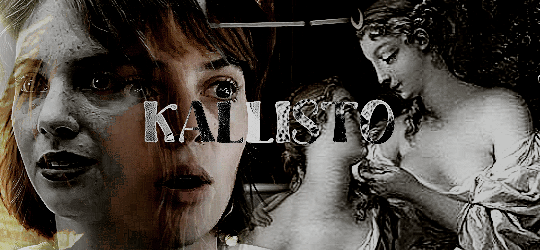






@stcreators event 08: women
Stranger Things Women as Women From Greco-Roman Literature
NANCY WHEELER— Dido, Queen of Carthage
legendary founder and first queen of the Phoenician city-state of Carthage.
ROBIN BUCKLEY— Kallisto
A hunting companion of the goddess Artemis. Zeus seduced Kallisto in the disguise of the goddess Artemis.
JOYCE BYERS— Andromache
Andromache was famous for her fidelity and virtue; her character represents the suffering of Trojan women during war.
KALI PRASAD— Circe
Circe was a sorcerer (pharmakeia) who was skilled in the magic of transmutation, illusion, and necromancy.
EL HOPPER— Pandora, The First Women
Zeus gave Pandora a storage jar (pithos) as a wedding gift which she opened, releasing the swarm of evil spirits trapped within. These would forever after plague mankind. Only
MAX MAYFIELD— Penthesilea
An Amazon queen who led her troops to Troy in support of King Priamos during the Trojan War.
ERICA SINCLAIR— Erato, Muse of Poetry
Erato was one of the nine Mousai, the goddesses of music, song and dance.
CHRISSY CUNNINGHAM— Helen of Troy
The Paris Trojan War began when Helen, the wife of Menelaos, the Spartan king, was abducted by the Trojan prince Paris.
#my post#mine#stranger things#stcreators#stedit#strangerthingsedit#dailystrangerthings#stladies#nancywheeleredit#robinbuckleyedit#elhopperedit#janehopperedit#chrissycunninghamedit#maxmayfieldedit#ericasinclairedit#joycebyersedit#nancywheelercentral#nancy wheeler#robin buckley#el hopper#jane hopper#max mayfield#joyce byers#kali prasad#erica sinclair#chrissy cunningham
56 notes
·
View notes
Text
i've got an idea for a high concept joke about Biden being in the middle of a presidential debate and misremembering being a Sicilian Hoplite in his youth during the Greco-Punic wars and talking about solving race relations with the Phoenicians at a bathhouse but I'm not really sure how to format it properly
307 notes
·
View notes
Text
Can we just let the Greeks have their gods? Why are people so obsessed with origins proving The Theoi Aren't Actually Greek™. I don't see anyone saying "well Hindu deities aren't actually Hindu, they're not from India! They're from the Proto-Indo-Europeans so aCkTUalY they're Eurasian Gods not from the Indian Subcontinent." Seems Hellenic Polytheist/Pagan spaces are hellbent on allowing Greeks to only claim deities whose origin is in the Mycenaean Pantheon. Otherwise they aren't actually Greek they're Minoan, Hittite, Phoenician, Egyptian, general ""ANE"", Etruscan (I guess), etc— then again even the Mycenaeans are robbed of autonomy because thats just a PIE pantheon like the Hittites. It's ridiculous.
Tracing the origin of deities is pretty awesome, but when you deny a culture its deities just because you can trace their worship back in history you're plainly being disrespectful. For example, Ašratu is a chief deity of the Amorite tribe, which came to rule Babylon. Thus their Goddess became apart of the "Babylonian Pantheon" as the Daughter in Law of An. Athirat an important Ugaritic (Canaanite) deity undoubtedly shares her origin with this Amorite deity, and became a principal Goddess in the "Ugaritic/ Canaanite Pantheon". Does that mean Ašratu isn't actually Babylonian and therefore (pretending they still existed) Babylonians can't lay claim to her as part of their heritage, culture, and pantheon? Or that Athirat isn't actually Canaanite therefore (if they still existed) Canaanites can't lay claim to her as part of their heritage, culture, and pantheon? No. That makes no fucking sense— Ašratu is Babylonian & Athirat is Canaanite even if the deities have their "origins" with the semi-nomadic Amorite culture.
Since Mesopotamian Ašratu was understood to be an Amorite deity, a connection between Ašratu’s and Athirat’s origins appears to be virtually certain. Being transferred to a different culture would have led to some adaptation of the Goddess to her new culture. This should stand as a caution not to apply specific details of Ašratu’s characteristics developed in Mesopotamia to Athirat simply because the earliest records attest to the former.” [X]
The same principles goes for the Greek Gods, just because a Theos' origin, for example Zeus, can be traced back to an earlier culture—*Dyḗus from the PIE people of the Pontic-Caspian Steppe—doesn't make Zeus any less of a GREEK deity.
This "they aren't Greek" trend is strongest with Aphrodite— whose worship probably "began" somewhere in the Ancient Near East primarily Cyprus or Phoenicia. The trend is also present and increasing with Apollo who has multiple different possible "origins."
If you're so obsessed with determining that none of the Greek Gods are actually Greek pick a different tradition to worship them in. Stop using "Hellenic" and say you're a PIE polytheist or Phoenician Polytheist or whatever tradition the """original version"""" of the Theos you are worshipping comes from. If you want to be a Hellenic Polytheist don't try and negate the Theoi's Greekness. Its bafflingly disrespectful especially since Greeks still exist and this is still their heritage.
No this isn't a "folkish" post its a salty post. And it is not directed at any one person but a phenomenon that pops up and seems to be increasing and I'm annoyed with it.
-not audio proof read-
[Edit, no I'm not talking about people who use 'Greek names' in Greco-Roman, Greco-Egyptian or any other syncretic traditions. I'm specifically talking about Hellenic Polytheist/Pagans who are obsessed with the Greek Gods being non-Greek because "origins"]
104 notes
·
View notes
Text
The Jewish Diaspora was not unique; ethnic enclaves were common in the Greco-Roman cities. Greek neighborhoods probably existed even in all of the non-Hellenic cities, and colonies of Syrians, Cretans, Phoenicians, Cypriots, Persians, Egyptians, and many others were widespread. Like the Jews, all of these “sojourners” (as they were called in official documents, even after generations of residence) remained quite attached to their homeland, and “every people, or fragment of a people, thrown into a foreign land continued to worship its ancestral gods.”
The difference was that most of the sojourners were willing to worship local gods too, including the gods of each particular city and the deified emperors of the Imperial Cult, and to participate in “the frequent festivals and sacrifices,” while devout Jews were not. This very clearly set the Jews apart and often stimulated antisemitism. But, unlike the Christians, people in the Jewish Diasporan communities usually were exempt from these pagan obligations, having successfully appealed to the authorities that their unwillingness to worship any other gods was inherent in their traditional faith—tradition being the whole basis for religious legitimacy in the eyes of Roman authorities. Indeed, that is why conversion so unsettled Roman authorities: it involved renouncing the faith of one’s ancestors.
Even most of the Jews of the Diaspora who did not assimilate were remarkably Hellenized. As noted, they spoke Greek and thought in Greek—Philo referred to Greek as “our language.” Most had taken Greek names, and “intermarriage was frequent.” All but a very few had so entirely lost their Hebrew that they worshipped in Greek and the Torah had to be translated into Greek. Many Diasporan Jews, probably the majority of them, had abandoned some provisions of the Law well before the arrival of Christianity. For example, the prohibition against eating with non-Jews probably was widely ignored. It seems equally likely that many took part in feasts and festivals having pagan significance, since tolerance of paganism had crept into even their scripture. In the Greek of the Septuagint, Exodus 22:27 was not translated as “You shall not revile God” but as “You shall not revile the gods.” Calvin Roetzel is surely right that this was an open declaration of tolerance, utterly “alien to Hebrew Scriptures.”
Equally dramatic evidence of a tolerant attitude toward paganism comes from the fact that the Diasporan Jews “did not even hesitate to [adopt] names derived from those of Greek deities, such as Apollonius, Heracleides and Dionysus,” or those of Egyptian gods—Horus was especially popular among the Diasporan Jews. Further proof of pagan inroads into Diasporan Judaism comes from the Jewish shrine in Elephantine in Egypt, where not only was Yahweh worshipped, but so were two goddesses who were said to be Yahweh’s consorts—Anath the goddess of war and Eshem the goddess of the sun.
24 notes
·
View notes
Text
The Unknown Origins of Christmas & Christianity
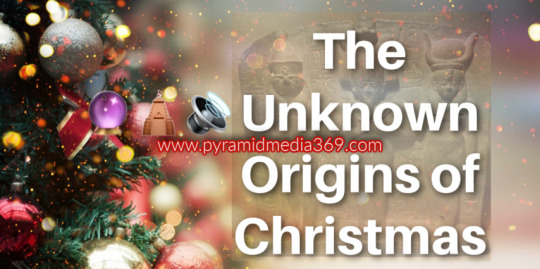
Original post: The Unknown Origins of Christmas & Christianity (pyramidmedia369.com)
There is a wide variety of artifacts below that detail the origins of the Christmas ritual. The information below will be quite alarming, because it can cause deep confusion depending on where you stand in your spiritual journey. There's a lot to uncover here. I'm only here to make you think. Lets get to it.
We will address the following:
Christ-Mass
Saturnalia
Saturn Worship
ACTS 14:12 + GENESIS 11:5-9 in the Bible
Who is Nimrod?
How does Nimrod tie to the story of Christ?
The original Virgin Mary story
The Winter Solstice
Christ-Mass & the start of Christianity
The word "Christmas" is a derivative of "Christ-Mass". With Mass being a common practice in Roman Catholicism, having a nature specific to certain dates for more than just astrological reasons. The roots of Christmas were first planted in ancient Rome with Saturnalia: the original ritual of Christmas. In 336 AD, Pope Julius I decided to call December 25th "Christ-Mass", in an effort to adopt and absorb the traditions of the pagan Saturnalia festival. This is just 11 years after the beginning of Christianity, which started in 325 AD by Constantine The Great at the Council of Nicea. At the CON, Constantine stated that religious peace could only occur if a single religion is imposed throughout the empire, therefore no one could leave the empire until they agreed on a Universal interpretation for Christianity. There were only 5 priests who disagreed with him. Therefore, the bible doctrine we read today was subjugated by votes. Meaning, the stories/scriptures they would or would not include in the bible had to be voted for by the Council of Nicea. Which is why 75 books were removed from the bible as Christianity was created.
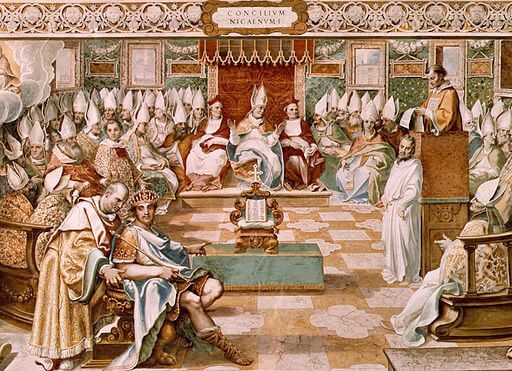
I wonder, why didn't Christianity evolve as its own semitic denomination? Yeshua (Jesus) was a Jew from the tribe of Judah by lineage, and the New Testament states his crucifixion was ordered by the Roman Catholic church. Why is Christianity a denomination of Catholicism, and not Hebrew customs? Weird.
Saturnalia
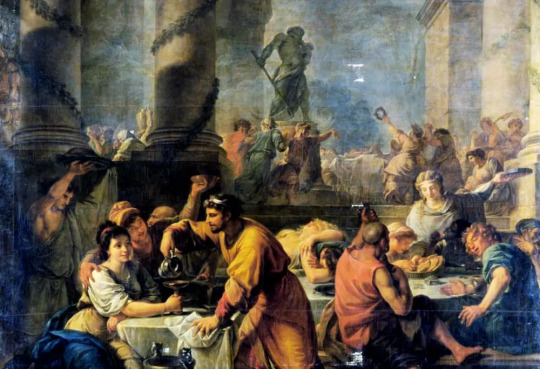
Saturnalia was originally a celebration of the god 'Saturn', which would last from December 17th through December 25th. I do recommend that you research the nature of these festivals on your own. Before it was Jesus Christ's birthday, it was Nimrod's birthday and was widely celebrated similar to the way we celebrate Christmas. To the Romans, Nimrod was called Saturn; the Greeks called him Kronos; the Egyptians called him Osiris; the Phoenicians and Canaanites called him Baal. Interesting, isn't it?
Saturn Worship

It's not just ancient Romania; Saturn does play an important role in our spiritual evolution for many different reasons. For starters, Saturn is associated as the Lord of Karma and Time. Honoring Saturn is not merely just a pagan practice, hence why the Hebrew Sabbath day is on Saturday, the day of Saturn. If you look up any Pre-Copernicus astrological facts, you will find that Saturn is revered as the highest heaven of all the planetary bodies. Yes, each planet is considered not just a god/goddess, but also a heaven and dimension. The energetic nature of these planets are described through the personification of said deities.
You can learn more about how the roles the planets played in the ancient pantheons of spirituality and astrology here: "How The Days Got Their Names?"
Saturnalia is an ancient Greco-Roman festival, which also explains why the Bible stories include characters/gods from Greek-Roman pantheon. For example..
'Acts 14:12' in the Bible
King James Version:
"And they called Barnabas, Jupiter; and Paul, Mercurius, because he was the chief speaker."
New International Version:
"Barabas, they called Zeus, and Paul they called Hermes because he was the chief speaker."
Mercury is the planet of communication, while Jupiter is the planet of rulership. Barnabus and Paul were appointed these names because of the social role they were playing among their tribe and society. This means that at a point in time, astrology was highly implemented by the progenitors of these said religions.
Who is Nimrod?

Nimrod is a son of Cush, grandson of Ham and great grandson of Noah. "He was a mighty hunter before (against) the Lord" - Genisis 10:9. He was rebellious to the God of the bible, YHWH/ENLIL. Nimrod was the architect and main builder of the Tower of Babel. In Sumerian language, this tower is called Etemenanki, "the stairway between heaven and earth". The purpose of this tower was initially built in dedication to Enlil's brother, ENKI, to go high enough to see the gods. It was built in a spot the Babylonians believed was the very center of our Universe. Rome, which is just Babylon in a different time, was the original city of Saturn.
During the construction of the Tower of Babylon, the peoples of the earth remained undivided, with one language and culture. But this was against God's orders. Read Genesis 11:5-9, where it describes how God made the builders scatter and divided their languages and kept them from being able to understand one another. This led to the final destruction of the tower.
How does Nimrod tie to the story of Christ?
After Nimrod's death (c. 2167 BC), his wife Semiramis promoted the belief that he was a god. She claimed that she saw a full-grown evergreen tree spring out of the roots of a dead tree stump, symbolizing the springing forth of new life for Nimrod. On the anniversary of his birth, she said, Nimrod would visit the evergreen tree and leave gifts under it. His birthday fell on the winter solstice at the end of December. This is how the Christmas Tree tradition originated.
Traditionally, a yule log was burned in the fireplace on Christmas Eve and during the night as the log’s embers died, there appeared in the room, as if by magic, a Christmas tree surrounded by gifts. The yule log represented the sun-god Nimrod and the Christmas tree represented himself resurrected as his own son, Tammuz who is Horus/Heru. Remember, the names are different because of the languages used throughout different kingdoms.
This story can also be found in the Sumerian story, The Epic of Gilgamesh, who is also Nimrod, who is Horus, who is Heru, who is Hercules. This is where the word "HERO" comes from! Let's get back on topic now...
The original Virgin Mary story
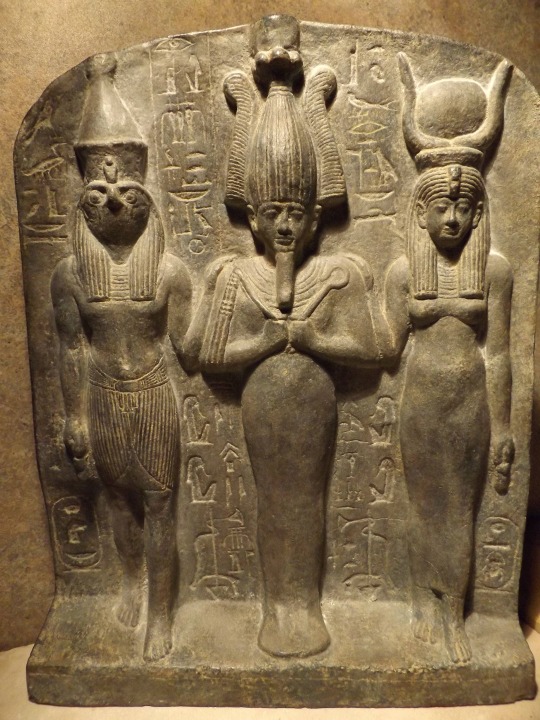
Osiris's story is almost exactly the same, just a few details make it more of a different story in other cultures. Nimrod's story is only missing the details of how his wife Semiramis, who is Isis, was able to conceive this miracle child. This is how the concept of the Holy Trinity began.
Nimrod-Semiramis-Tammuz version:
"Nimrod's uncle Shem killed Nimrod and scattered his remains across the land. When his wife became pregnant five month's later, she proclaimed that she was made pregnant by the rays of the Sun, which was supposedly her husband Nimrod."
Osiris-Isis-Horus version:
"But one night Set, hunting by the light of the moon, found the chest, and, recognizing the body, tore it into fourteen pieces, which he scattered up and down throughout the land. When Isis heard of this, she took a boat and gathered the fragments of Osiris's body. Wherever she found one, there she built a tomb and pieced Osiris back together, who was then brought back to life. At this moment, Isis conceived Horus who later avenged Osiris's death."
The Winter Solstice
Ironically, the Sun cycle dies for 3 days. Its cycle is renewed, and the Sun begins to rise again on the 3rd day. Sound familiar? Throughout these 3 days, the Sun is at its lowest point out of a complete 365-day year. On December 25th, the Sun moves one degree northward and is symbolically born again!
"The New Testament stories are based on the initiation ceremonies and esoteric secrets including astrology and Sun worship that were performed and communicated in the Mystery schools of Sumer, Babylon, and Egypt. In modern times, they are performed in Freemasonry, Order of the Eastern Star, Rosicrucianism, Order of the Golden Dawn, Thule Society, etc. But they are presented as a literal story to fool the people; especially Christianity, Judaism and Islam." - David Icke
Conclusion:
So Nimrod's story is Osiris's story. Considering that Horus is an incarnation of Osiris, the Horus legend also belongs to Nimrod as well. I can see how the confusion begins for many of us. Because Nimrod was killed by his own uncle - and Horus sought revenge on his uncle Seth who killed his father, Osiris. I know you're like, "How did he kill the person that killed him?" LOL there's so many empty blanks to fill in!
The ancient story says Isis used the pyramid of Giza to draw Osiris's spirit down into his body once she put him back together, after being killed and dismembered by his brother Set. It is also said that the Egyptians used Orion's belt as a gateway aka portal to travel to Earth's dimension with the use of the Pyramid. These are the missing details in the other stories. I shall return!
Thank you for reading!
If you do not truly understand how the planets, ancient Gods, and humanity are all connected, please feel free to reach out to me and ask any questions you may have at [email protected]. I try to leave clues in my previous articles, but I understand information has to be organized based upon your questions and needs. - Phoenix Son
#esoteric#shadow work#pyramid media#peace#higher self#mantra#nature#inner peace#meditate#spiritualism#Christmas#holidays#xmas#festive#christmas tree#happy holidays#saturnalia#traditions#yule#yuletide#pagan holidays#happy yule#Nimrod#Enki#Enlil#Sumeria#mesopotamia#Ancient Egypt#Egypt#Osiris
5 notes
·
View notes
Text
The use of the poetic priamel by Herodotus in the Prologue of Histories and the foundation by him of history as distinct genre
"But it is not merely the mythological content of the prologue that will have evoked the poetic tradition for Herodotus’ audience; so too the distinctive argumentative structure used by Herodotus to articulate both the (allegedly) non-Greek traditions and his own response to them. That distinctive argumentative structure, with deep roots in the Greek poetic tradition, is the priamel, as William Race first recognised.62 As defined by Race, the priamel is a two-part structure that leads from an introductory ‘foil’ (comprising two or more subjects or perspectives) by means of contrast and analogy to the ‘climax’, a particular point of interest or importance. Surveying the use of the priamel from Homeric epic through Hellenistic poetry, Race identifies five essential features of the form: 1) a general context or category; 2) an indication of quantity or diversity in the foil; 3) a ‘capping’ particle that marks the arrival of the climax; 4) an indication of relative (typically superlative) merit to give the climactic term special prominence; and 5) finally, the subject of ultimate interest.63
All five of these features are found in 1.1-5, although not all at once,
since Herodotus’ opening is an ingenious variation on the form of the priamel, and only gradually revealed as such. Race acknowledges in passing that Herodotus’ priamel is ‘more diffuse than its poetic prototypes’, while Hayden Pelliccia, noting that priamels tend to be immediately recognisable as such, proposes the alternative label ‘false-start recusatio’.64 This term rightly underscores the misdirection that characterises the first four chapters, whereby Herodotus himself seems to endorse the foreigners’ belief in the
primeval origins of the Greco-Persian wars.65 It is also true, however, that the common features shared by Herodotus’ introduction and the priamel are brought into sharp focus in chapter 5, which demonstrates decisively how Herodotean historiê diverges from the stories of old cited by Persian and Phoenician authorities. By this point the general context or category (1) of the discussion is well established: namely, Herodotus’ search for the αἰτίη of the Greco-Persian conflict, the person(s) responsible for beginning the hostilities between East and West. At the beginning of chapter 5, the Persian account of that origin, detailed in chapters 1 through 4, is summarised in a µέν-clause (5.1); then the diversity of the foil (2) is developed, as the Phoenician counter-claim concerning the circumstances of Io’s departure from Argos follows in a δέ-clause (5.2). These two foreign perspectives are then summarised immediately before the climax (5.3):
ταῦτα µέν νυν Πέρσαι τε καὶ Φοίνικες λέγουσι. ἐγὼ δὲ περὶ µὲν τούτων
οὐκ ἔρχοµαι ἐρέων ὡς οὕτως ἢ ἄλλως κως ταῦτα ἐγένετο, τὸν δὲ οἶδα
αὐτὸς πρῶτον ὑπάρξαντα ἀδίκων ἔργων ἐς τοὺς Ἕλληνας, τοῦτον
σηµήνας προβήσοµαι ἐς τὸ πρόσω τοῦ λόγου …
Now this is what the Persians and Phoenicians say, but I for my part
am not going to say concerning these incidents that they happened in this way or some other. Instead, I will indicate the man whom I myself know first initiated unjust acts against the Greeks, and proceed onwards with my account …
As the first words of the second quoted sentence (ἐγὼ δέ) demonstrate, the climax is indicated not only by a ‘capping’ particle (3), but also by a prominently placed pronoun, effecting a shift of person—a ‘pronominal cap’, in the terminology of Elroy Bundy.66 The extraordinary merit (4) of Herodotus’ chosen topic is marked by the superlative πρῶτον, and the relative clause within which it falls (τὸν δὲ οἶδα αὐτὸς … τοὺς Ἕλληνας) identifies the subject of the author’s interest (5)—but only to a degree, specifying his activity but not yet supplying his name. An additional common feature of poetic
priamels is the deferral of crucial information until the very end, a method of achieving closure after arousing audience expectation.67 Herodotus makes use of this technique as well, withholding Croesus’ name until the beginning of the narrative proper in chapter 6, where it makes a notably dramatic entrance in asyndeton (6.1): Κροῖσος ἦν Λυδὸς µὲν γένος, παῖς δὲ Ἀλυάττεω, τύραννος δὲ ἐθνέων τῶν ἐντὸς Ἅλυος ποταµοῦ … (Croesus was Lydian by birth, a son of Alyattes, and tyrant of the tribes west of the river Halys …).
The rhetorical elaboration of Herodotus’ introduction is especially evident when compared to the opening sentence of Hecataeus’ Genealogies (FGrHist 1 F 1a = F 1 Fowler, EGM)
Ἑκαταῖος Μιλήσιος ὧδε µυθεῖται· τάδε γράφω, ὥς µοι δοκεῖ ἀληθέα
εἶναι· οἱ γὰρ Ἑλλήνων λόγοι πολλοί τε καὶ γελοῖοι, ὡς ἐµοὶ φαίνονται,
εἰσίν.
Hecataeus of Miletus speaks as follows: I write the following accounts as they seem to me to be true, since the stories of the Greeks are both many and laughable, as they appear to me.
Herodotus adopts many of these features in his prologue: the prominent positioning of the author’s name and place of origin, the brief opening clause with a deictic form (ὧδε), the switch from third-person self-reference to first person self-reference, and the forceful contrast between the logoi of others and the author’s own revisionist view. It is in the framing of this last feature that Herodotus parts company with Hecataeus most decisively, and the question remains why Herodotus chose to construct his prologue on the model of the poetic priamel. We can begin to answer this question by noting
the special emphasis this construction places upon three important features that distinguish his historiê from epic poetry, the tradition most strongly evoked by the stories of abduction and counter-abduction recounted in 1.1-5.
The first of these features is the first-person authorial voice, which
proves to be a constant presence throughout the Histories, and as such a striking departure from Homeric narrative technique.68 Here the priamel construction enables the Herodotean ἐγώ to make its first appearance in duly emphatic fashion, as the convention of the pronominal cap heralds the importance of the authorial ‘I’ in the Histories. Moreover, Herodotus pointedly modifies a second feature of the priamel in characterising his subject matter, since the climactic superlative adjective πρῶτον does not stand by itself, but undergoes crucial qualification. For Herodotus’ claim is (obviously) not that
Croesus’ unjust acts against the Greeks within living memory predate the primeval abductions just recounted as foil, but rather that Croesus is the first aggressor of whom he has personal knowledge, τὸν δ’ οἶδα αὐτὸς πρῶτον ὑπάρξαντα ἀδίκων ἔργων ἐς τοὺς Ἕλληνας: ‘the one whom I myself know first initiated unjust acts against the Greeks’.69 (I note here parenthetically that, in addition to its specialised function in this context as a superlative marking the climax of a priamel, πρῶτος also serves from the beginning of the Greek poetic tradition to mark events of primary importance for narration, even when they lack absolute temporal priority.70) Herodotus thus delimits his account of the war’s origins, at least, by contrast with events of the ‘deep past’ recounted in Homeric epic and other genres of ‘high’ poetry—events so distant in time that not even conscientious historiê can determine their causal connection to recent Greco-Persian hostilities.71 Third and finally, by explicitly opposing his own view about the origins of the Greco-Persian wars to those of the Persians and Phoenicians before him, Herodotus acknowledges that his account of the conflict is part of an ongoing conversation or dispute, a virtual tradition of international debate in which he responds to and departs from previous explanations. This explicit acknowledgement of predecessors again marks a significant deviation from storytelling convention in Homeric epic, which, although the product of long-standing oral tradition, never mentions any of the earlier alternative versions that comprise that tradition: the Homeric bard is imagined as either taught by the gods (the Muse or Apollo), or self-taught, or both.72 Thus Herodotus’ use of the poetic priamel form also serves to highlight his role as adjudicator of the various traditions that he has gathered, as well as his discovering ‘the problem of sources’, which Fowler considers ‘the unique element in his voiceprint’ and ‘an integral part of his self-perception as an historian’.73"
From the article of Charles C. Chiasson "Herodotus' Prologue and the Greek Poetic Tradition", Histos 6 (2012), 114-143
3 notes
·
View notes
Text
“In 1907, in the old Hittite capital, Boghaz Koi in Cappadocia, Winckler discovered the original treaty of about 1400 BC between the Khatti or Hittites and their kinsmen neighbors on the east, in Ancient Persia, the Mitani (who were the ancient Medes ). In this treaty they invoked the actual Aryan gods of the Vedas of the Indian branch of the Aryans and by their Vedic names. Significantly the first god invoked is the Vedic Sun-god Mitra (i.e., the “ Mithra ” of the Greco-Romans), as some of the later Aryans made separate gods out of the different titles of the Father God. His name is followed by In-da-ra, that is the solar Indra or ‘Almighty,' the principal deity of these Indo-Aryan Vedic scriptures…
The ruling clan in India (celebrated in the Vedas) were the most ardent of all devotees of the Sun and Fire cult associated with worship of the Father-god Indra... like the Hitto-Phoenicians [who] were especial worshippers of the Father-god Bel (also called by them ‘ Indara ')...”
Laurence Austine Waddell, The Phoenician Origin of Britons Scots and Anglo-Saxons
3 notes
·
View notes
Note
You're very knowledgeable.
I'm reading a book and it says "It is worth noting that most ancient cultures, including that of the great philophers of ancient Greece, did not think of people from other cultures as being truly human."
Is this accurate?
Thank you! And thank you for your question!
I think this is not accurate. As a society, ancient Greeks had their positive and negative stereotypes about other cultures but that doesn't mean they didn't see them as humans. This goes for other ancient peoples as well. For the Mediterranean: How can you trade with, marry, and fight other people if you don't consider them as human as you?
When ancient peoples write they spoke to people from other cultures there was something like a fascination or a - at worst - some contempt for "weird" things the other culture did. But most times it was like "I spoke to an Egyptian", "I traded with Phoenician" and that's it. Maybe they also remarked some of their foreign characteristics (hairstyle, clothing, skin color, face features) because people didn’t met foreigners even less often than today, and the event was remarkable to them.
Some Greeks were under the impression that extreme heat or extreme cold produced physically more resilient people, which carries some truth. Like, someone from a very northern country would have a more suitable body type to deal with extremely low temperatures compared to a Mediterranean person, and their lighter would absorb the limited light in a better way. That's not seeing northern peoples as objects, merely seeing them as different people. Surely, some assumptions were wrong and a bit ignorant but it was more than 2000 years ago. People didn't even know why snow existed, and their guesses reflected they knowledge about the physical world.
Another factor for wanting to see the people of the other culture as different was the classic asshole superiority or to prove that their own people were stronger and "more men" than the others in times of war for courage and intimidation. David Daulton in Quora explained it better, in the thread What did the Greeks and Persians think of each other during the Greco-Persian wars?
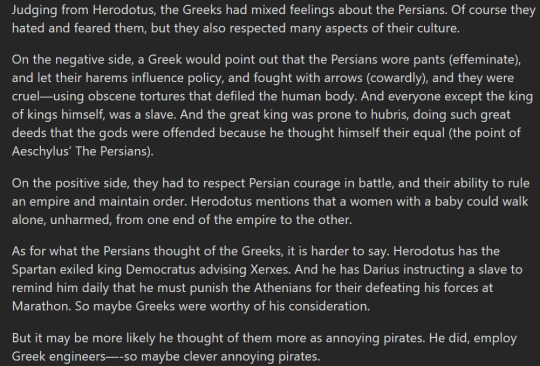
You can see the predicable pettiness or admiration people can have and it stays the same in all ages. I think the author of the book you are reading dehumanizes the ancient peoples with this characterization, and also assumes that everyone shared the same opinion. The society you come from may view negatively some elements of other cultures, but at the same time you know your fellow countrypeople know other humans are... human, and not everyone shares the same opinion about these cultural stereotypes.
17 notes
·
View notes
Text
Imperial Rome and Italy Superior
Imperial Rome and Italy Superior is a necessary post to explain the Venetian (Italian) influence of Florida, formally, called La floridas, which means the land of the flowers.
#foogallery-gallery-3108 .fg-image { width: 150px; } #foogallery-gallery-3108 .fg-image { width: 150px; }
Flag of Mexico
The current flag of Mexico features the red, white, and green colors of the Maurs, but this version of the Mexican flag features the Eagle (the phoenix) killing the serpent (Dragon), which symbolizes Rome’s (the Vatican’s) victory over the Saracens (Muurs) and pagans (Hebrews) for control over Granada Land/Promised land in the Americas
Roman Empire Philip the Arab, 204-249.
Imperial Rome and Italy Superior was in the Americas since I found an ancient Roman coin of Roman Emperor Philip I the Arab (Saracen) with the Imperial Roman Eagle on the reverse side of the coin with a serpent in its mouth. The flag of Mexico features the same exact Eagle of Rome with the serpent in its mouth, which suggests that the first Vatican City was in Mexico near Teotihuacan (see blog post, “Teotihuacan is the home of Thoth”). The fact that Philip I the Arab was born in Arabia leaves no doubt that the flag of Mexico is the Imperial Flag of Rome since Southern Arabia was in Mexico.
Scallop Seashells and Cobra shields.
Terra-cotta border around the entrance arch at ponce del Leon hotel with Scallop seashells and cobra shields that spell out the phrase, Ponce de Leon, which means House of Lion.
Scallop Seashells at the Ponce de Leon Hotel
Scallop seashells decorate the terra-cotta border around the main front entrance of the Ponce de Leon Hotel. The symbol of the Scallop Shell of Greco-Roman civilizations is a symbol of value (wealth) due to its association with the Murex shellfish (Purple fish) and fertility. Fertility is also the theme in what may be the best known pre-modern reference to the scallop shell: Sandro Botticelli's The Birth of Venus (1452). In that work, the scallop shell is associated with the Greek goddess Aphrodite and her Roman counterpart, Venus; Venus is symbolically born out of a shell (an egg).
Hotel Alcazar in St. Augustine, FL.
Cordova, Spain is famous for its Moorish Architecture such as the Alcazar. Likewise, Saint Augustine is famous for its Moorish revival architecture such as the Hotel Alcazar, now known as the Lightner Museum. Now, if we include Seville Street (as in Seville, Spain), in Saint Augustine, Florida, we can agree that Saint Augustine looks like Andalusia, Spain with all of these place names that are associated with the Moors of the Iberian Peninsula, which was located in La floridas according to my “Gibraltar of the West” blog post.
Saint Augustine of hippo
The city of Saint Augustine, Florida existed prior to the Spanish invasion of the 1500’s since the city is named after Roman Saint Augustine of Hippo, who was a Consul for Roman North Africa. Saint Augustine (13 November 354 – 28 August 430) was a Berber (Saracen) from North Africa that help to establish Christianity in the Western World
Ponce de Leon Hotel - Phoenician purple Room
Paintings of Venetian sail ships, Moormons (male mermaids), and mermaids decorate the walls. Speaking of the Phoenicians, the Ponce del Leon Hotel has a room trimmed in Cypress wood and with a Phoenician purple mural on the ceiling. Purple is the highest spectrum of light and it symbolizes the crown chakra, which is the most high god.
Ponce de Leon Hotel walkway
A lavish Ponce de Leon Hotel walkway with stained glass windows, and with wood trim made from Cypress wood.
The mosaic marble floor
The mosaic marble floor under the Rotunda at the Ponce de Leon Hotel
The Rotunda at the Ponce de Leon Hotel
The Rotunda is a representation of the 8-pointed flag of the Marinid Sultanate/ Dynasty. Some say it is also that of the Almohad Dynasty. Marinid is from the words Marine and Mariner, aka, the Sea People that were Moormons and Mermaids. Mer/ Mar is Latin for sea. The star on the Moorish red flag is called the Ogdoad or 8-pointed star, and it is a symbol of life, fertility, and wards against evil. It also is a Octagram. Octagrams are formed from overlapping squares which emphasize duality: yin and yang, male and female, spiritual and material. Squares are often connected with the physical world: four elements, four cardinal directions, etc. Together, they can mean both positive and negative aspects of the four elements, for example, balancing them to create harmony/ life.
The Flagler Room at Ponce de Leon Hotel
The ballroom now called the Flagler room has 12 Austrian Crystal chandeliers at the Ponce de Leon Hotel
Ponce de Leon Hotel Chandeliers
The ballroom now called the Flagler room has 12 Austrian Crystal chandeliers at the Ponce de Leon Hotel
Ponce de Leon Hotel - Water Fountain
One of several water fountains at the Ponce de Leon Hotel. This one is based off the cosmos since the ball or point at that top is the Pole Star or North Star. The four turtles below represent the four major cardinal points of the zodiac. The twelve turtles that surround those four turtles, represent the twelve signs of the zodiac which are also the 12 months of the year, and the 12 Apostles of Christ.
The Ponce de Leon Hotel - water fountain
The Ponce de Leon Hotel is one of the most extravagant and luxurious pieces of property in the world. It is located at 74 King Street and on the corner of Granada Street. This is a closeup view of one of the water fountains.
Ponce de Leon Hotel - Front View
The Ponce de Leon Hotel is one of the most extravagant and luxurious pieces of property in the world. It is located at 74 King Street and on the corner of Granada Street
Aerial view of Ponce de Leon Hotel
In this post are some aerial views of the Ponce de Leon hotel to show you how vast this Venetian Gothic Castle/ Mansion is.
Ponce de Leon hotel - Aerial view
In this post are some aerial views of the Ponce de Leon hotel to show you how vast this Venetian Gothic Castle/ Mansion is
Ponce de Leon Green Dragon stem vents
The two landing towers in the blimp image also serve as hydro-electric towers/ generators that supplied free hydro-electric energy (free Energy) generated from steam (water), since one tower is the anode (the male or positive charge from the hot water that it stored) and the other tower is the cathode (the female or negative charge from the cold water that it stored). More evidence of free energy is the Ponce de Leon green steam dragons that once served as high pressure release valves to release hot steam (fire) from the structure when the lights were turned on (see post image of green steam dragon). These green steam dragons had a red-light bulb in their mouths to resemble fire breathing dragons when the power was turned on during the nighttime.
Landing platform for blimp - Tartary
This colorized image from late 1800's of a blimp in New York City that is anchored to a skyscraper’s landing tower. This image is a perfect example of how Moorish Nobles would make their grand entrance into these old-world structures.
Landing platform for blimp - Tartary
This colorized image from late 1800's of a blimp in New York City that is anchored to a skyscraper’s landing tower. This image is a perfect example of how Moorish Nobles would make their grand entrance into these old-world structures. You can see several other blimps in the background too.
Ponce de Leon Hotel landing platform.
Colorized image from the late 1800’s of a blimp getting ready to land on one of the two landing platforms (towers) to choose from at the Ponce de Leon Hotel. The blimp anchors to one of the towers and a landing bridge comes out to connect the blimp with the tower so that the flight attendants on the blimp could make a grand entrance into this fabulous Venetian Gothic Castle, known as the ponce de Leon Hotel (see post images of a blimp anchored to the skyscraper’s tower for an example).
Ponce De Leon Hotel in the late 1800's
Throwback image from the late 1800’s of the front entrance of the Ponce de Leon Hotel shows you a medieval-style castle draw bridge or gate with two pillars of Tartarian red brick masonry that are decorated with the face of a Medici Lion on each pillar of masonry, so yes..., Ponce de Leon means the House of the Lion, based upon the evidence. This lion is called Marzocco (Morocco*?) and is a symbol of protection for the city of Florence, Italy, aka, the Free Republic of Florence against the Imperial Eagle of Rome
Medici Lion in Saint Augustine, FL.
Medici Lion at the Bridge of Lions in Saint Augustine. This lion is called Marzocco (Morocco*?) and is a symbol of protection for the city of Florence, Italy, aka, the Free Republic of Florence, Italy against the imperial Eagle of Rome.
Alessandro de' Medici, the Moor
Alessandro de' Medici (22 July 1510 – 6 January 1537), nicknamed "il Moro" due to his dark complexion, Duke of Penne and the first Duke of the Florentine Republic (from 1532), was ruler of Florence from 1530 to his death in 1537. The first Medici to rule Florence as a hereditary monarch, Alessandro was also the last Medici from the senior line of the family to lead the city. His assassination at the hands of distant cousin Lorenzaccio caused the title of Duke to pass to Cosimo I de Medici, from the family's junior branch. There were several Pope's in his family, one of them was Pope Leo XI
The red flag of the Mayan Moors. These Mayans established Florida after their homeland Atlantis in Mexico had sunk.
Phoenician Mayan Moor with Dredd locks and with a red flag in his hand.
Phoenician Bust
This is a Phoenician Bust of a Blackamoor. Yes, the Phoenicians were Negroes/ Nagas, aka, Black people.
Venice in West Palm Beach
Whitehall was initially the Whitehall Hotel with a Moorish red roof (see post image), but now it is called the Whitehall Museum. This building even has a small train station attached to it that is made from copper and it has an old train inside of the station
Whitehall Museum on the water
Whitehall was initially the Whitehall Hotel with a Moorish red roof (see post image), but now it is called the Whitehall Museum. This building even has a small train station attached to it that is made from copper and it has an old train inside of the station
Whitehall Museum
Whitehall was initially the Whitehall Hotel with a Moorish red roof (see post image), but now it is called the Whitehall Museum. This building even has a small train station attached to it that is made from copper and it has an old train inside of the station
Inside Kapok Tree Restaurant
Inside Kapok Tree Restaurant
Inside the Kapok Tree inn Restaurant
Inside the Kapok Tree inn Restaurant
The Kapok Tree Inn
The inside of Kapok Tree Inn Restaurant
Inside of the Kapok Tree Inn
Inside of the Kapok Tree Inn
The Kapok Tree Inn Garden
The Kapok Tree Inn Garden
Two Medici Lions at entrance of Kapok Tree Inn
These two lions are known as the Medici Lions because they once belonged to Grand Duke Ferdinando I de’ Medici and adorned Villa Medici, his home in Rome, until they were moved to Loggia in 1789. This lion is called Marzocco (Morrocco*?) and is a symbol of protection for the city of Florence, Italy, aka, the Free Republic of Florence against the imperial Eagle of Rome. The heraldic lion—also known as the Marzocco lion—is the animal symbol representing the free Republic of Florence. As the legend goes, the Florentine Republic chose the symbol of the lion over other animals because lions can tear apart the eagle, which is the symbol of imperial power
The Kapok Tree Inn Italian Gardens
The Kapok Tree Inn Italian Gardens. A taste of old world Florida dinnning
The Kapok Tree Inn Water Fountains
The Kapok Tree Inn Water Fountains
The Kapok Tree Inn
The Kapok Tree Inn, a taste of Italy
The Venetians are named after their city Venice, Italy, which is a city built around water with a serious of water canals. Likewise, Florida is a state with thousands of water canals similar to the ones in Venice, Italy. Venice was established by those Phoenician Moors that conquered the Iberian Peninsula, Spain, Italy, etc., which explains why Venice is a water canal city since the Moors as mariners were sea people (see image of Phoenician Maur); and this also explains the Moorish/ Tartarian architecture found all throughout Venice, Italy.
The Phoenicians were initially the Naga-Maya (Mayans) that civilized the world after their home Teotihuacan (the capital of Atlantis) had sunk (see blog post, “Teotihuacan is the home of Thoth). In addition, the Phoenicians are also from the Americas: https://www.americaistheoldworld.com/the-phoenicians-are-from-the-americas/.
These Naga-Maya (Phoenicians/ Atlanteans/ Egyptians) came to Florida and built the Moorish/ Tartarian architecture throughout Florida: https://www.americaistheoldworld.com/gibraltar-of-the-west/.
In this post are images of the Kapok Tree Inn and its exotic Italian (Venetian) restaurant, which is located around the Sam Ash Music Store, in Clearwater, Florida, near Tampa Bay (Bey) and by the Bay bridge. The Venetian Gothic Architecture (Moorish or Tartarian Architecture) is amazing. Imagine how this place looked like in her prime! The Kapok Tree is the Sacred Tree of the Aztecs (Atlanteans) and Mayans (Egyptians), so yes…, Phoenician Mayans (Moors/ Tartars) built this. This place has two Medici lions at its entrance, which are a symbol of Florence, Italy.
The city of Florence was established by Julius Caesar, around 59 BC, as a settlement for his veteran soldiers and was named originally Fluentia, because it was built between two rivers, which was later changed to Florentia (“flowering”). Florentia sounds a lot like Florida, which also means Flowers or the land of flowers. In 1513, Spanish explorer Juan Ponce de Leon named the state La Florida – “Land of Flowers” – for the Easter season in which he made his discovery.
Italy and Florida and both shaped like boots:
Also, Florida and Italy are both shaped like boots, and they are both Peninsula’s. The only difference is that Florida is shaped like an upside-down boot. We know that Rome is in Italy, so Florida being shaped like the Country of Italy suggests that the original Italy was in the Americas, which equates to the original Rome being in the Americas by default since Rome is in Italy.
Additionally, Italy and Florida share some of the same city place names, such as: Naples, Venice, Florence, and Milan. We can also Include Rome, Georgia, since Florida is attached to Georgia and Florida used to be a huge territory of land called La Floridas (Tameri), which included Georgia, most of North America, and some parts of Canada and Mexico. Georgia also has a Milan and a Florence.
Yes, the European Italy (Rome) was patterned after greater Italy or Italy Superior that was called La floridas. I say this because Ancient Rome and Greece was in the Americas: https://www.americaistheoldworld.com/ancient-greece-and…/.
Additionally, the first Vatican City was in Mexico near the Capital of Atlantis, which was Teotihuacan: https://www.americaistheoldworld.com/teotihuacan-is-the…/.
Alessandro de’ Medici (22 July 1510 – 6 January 1537), nicknamed “il Moro” (the Moor) due to his dark complexion, Duke of Penne and the first Duke of the Florentine Republic (from 1532), was ruler of Florence from 1530 to his death in 1537. He was the first Medici to rule Florence as a hereditary monarch, Alessandro was also the last Medici from the senior line of the family to lead the city. His assassination at the hands of distant cousin Lorenzaccio caused the title of Duke to pass to Cosimo I de Medici, from the family’s junior branch.
The Medici family was very powerful in medieval history, since there were several Pope’s in the Medici family, one of them was Pope Leo XI. Pope Leo XI (Italian: Leone XI; 2 June 1535 – 27 April 1605), born Alessandro Ottaviano de’ Medici, was head of the Catholic Church and ruler of the Papal States from 1 April 1605 to his death.[1] His pontificate is one of the briefest in history, having lasted under a month. He was from the prominent House of Medici originating from Florence.[2]
The Medici family resigned from the Papal States, due to infighting stemming from this family not wanting to be a part of the now corrupted Papal States. However, when you are a part of an organized gang (the Vatican) you can’t just leave without war/ fighting, hence the ole true saying, “Once you are in you can’t get out.”
As a result of the conflict between the Medici’s and the Vatican, the Medici’s created the Medici lion. This lion is known as the Medici Lion because it once belonged to Grand Duke Ferdinando I de’ Medici and adorned Villa Medici, his home in Rome, until they were moved to Loggia in 1789. This lion is called Marzocco (Morocco*?) and is a symbol of protection for the city of Florence, Italy, aka, the Free Republic of Florence, Italy against the imperial Eagle of Rome.
The heraldic lion is the animal symbol representing the free Republic of Florence. As the legend goes, the Florentine Republic chose the symbol of the lion over other animals because lions can tear apart the Imperial eagle of Rome, which is the symbol of imperial power: https://www.florenceinferno.com/marzocco-symbol-of-florence/.
Two Medici Lions at the Whitehall Hotel:
In addition, at Whitehall in West Palm Beach, Florida, the Home of Robber Baron, “Henry Morisson Flagler,” there is a fabulous Venetian (Phoenician) mansion by the water that also has two Medici Lions at the front entrance with a giant Kapok Tree of the Mayans on the property: https://www.youtube.com/watch?v=shNollkkukQ&t=10s. The middle name of Flagler is Morisson and it means “son of the Moor.” Could Flagler really be the son of a Moor or the conqueror of the Moors since he claimed towns and properties that belonged to the Moors? It was a little bit of both.
Whitehall was initially the Whitehall Hotel with a Moorish red roof (see post image), but now it is called the Whitehall Museum. This building even has a small train station attached to it that is made from copper and it has an old train inside of the station (see post images).
The Lion Gate Bridge:
We must also consider the Lion Gate Bridge in Saint Augustine Florida since it is also Venetian Gothic Architecture. This bridge has a Medici Lion named Marzocco at the entrance of the Lion Gate (see post image), which leads directly to the House of the Lion, which translates in Spanish as “Ponce de Leon.” Ponce de Leon is now part of Flagler College. The flag of Flagler College is a red crest or shield with a golden Medici Lion on it, which supports the fact that Ponce de Leon means, “House of the Lion.”
In addition, here is a throwback image from the late 1800’s of the front entrance of the Ponce de Leon Hotel shows you a medieval-style castle draw bridge or gate with two pillars of Tartarian red brick masonry that are decorated with the face of a Medici Lion on each pillar of masonry, so yes…, Ponce de Leon means the House of the Lion, based upon the evidence. This lion is called Marzocco (Morocco*?) and is a symbol of protection for the city of Florence, Italy, aka, the Free Republic of Florence against the Imperial Eagle of Rome.
Saint Augustine, Florida is oldest city in America allegedly founded in 1565 by a Spanish admiral, which is 40 years older than the founding of Jamestown Virginia. St. Augustine is the oldest continuously occupied European settlement in the continental U.S. Tourist attractions include two national monuments that are sites of old Spanish forts: Castillo de San Marcos and Fort Matanzas.
The city is also known for its spectacular Moorish Revival and Spanish Renaissance Revival buildings from the late 19th century. These include the former Hotel Alcazar and Ponce de Leon Hotel, both built by industrialist Henry Flagler. The Alcazar now houses St. Augustine City Hall and the Lightner Museum, which is known for its collection of 19th century fine and decorative art. The Ponce de Leon is now part of Flagler College.
The Ponce de Leon Hotel:
The Ponce de Leon Hotel is one of the most extravagant and luxurious pieces of property in the world. It is located at 74 King Street and on the corner of Granada Street. Wow, what a location since King means sovereign ruler and Granada is Spanish for the pomegranate fruit, which is a symbol of the Promised Land of Jerusalem, when this fruit is fully bloomed, since it resembles the shape of the 6-pointed Star of David. Yes, Granada Land (the promised land) was in the Americas, and it covered La Floridas, parts of Canada, Mexico, Central America, and South America: https://www.americaistheoldworld.com/granada-land-is-the-promised-land-of-israel/.
According to the Torah (Old Testament of the Bible), Jewish tradition teaches that the pomegranate is a symbol for righteousness because it is said to have 613 seeds that corresponds with the 613 mitzvot or commandments of the Torah. In some artistic depictions, the pomegranate is found in the hand of Mary, mother of Jesus.
The pomegranate plant arrived in Rome via Carthage, which explains why the ancient Romans referred to pomegranate fruits as ‘apples of Carthage’ (Tunis=Tennessee). The people of Carthage were a branch of the Phoenicians. Pomegranate is known in Egyptian Hieroglyphics as “Ramen.” In Hebrew Rimon, means pomegranate. Both Ramen and Rimon are the origin of the term Roman, which means Promised Land.
Florida also has a Granada in Sarasota, Florida. Granada was a stronghold for the Moors of Spanish Iberia. However, the original Iberian Peninsula and Hispaniola (Spain) was in La Floridas, which was a huge territory of land once. Please refer to the above blog post, “Gibraltar of the West,” for evidence on this. Now that we know the significance of Granada let’s look at some of the images of the Ponce de Leon Hotel.
The Venetians/ Phoenicians were a highly Advanced Nation of people with Flying Machines and Free Energy Technology:
In this post is a colorized image from the late 1800’s of a blimp getting ready to land on one of the two landing platforms (towers) to choose from at the Ponce de Leon Hotel. The blimp anchors to one of the towers and a landing bridge comes out to connect the blimp with the tower so that the flight attendants on the blimp could make a grand entrance into this fabulous Venetian Gothic Castle, known as the ponce de Leon Hotel (see post images of a blimp anchored to the skyscraper’s tower for an example).
The two towers in the blimp image also serve as hydro-electric towers/ generators that supplied free hydro-electric energy (free Energy) generated from steam (water), since one tower is the anode (the male or positive charge from the hot water that it stored) and the other tower is the cathode (the female or negative charge from the cold water that it stored).
More evidence of free energy is the Ponce de Leon green steam dragons that once served as high pressure release valves to release hot steam (fire) from the structure when the lights were turned on (see post image of green steam dragon). These green steam dragons had a red-light bulb in their mouths to resemble fire breathing dragons when the power was turned on during the nighttime.
In this post are some aerial views of the Ponce de Leon hotel to show you how vast this Venetian Gothic Castle/ Mansion is. The main entrance room of the Ponce de Leon Hotel features an 8-pointed rotunda on the ceiling with a polished marble mosaic floor. The ceilings are decorated with remarkable mural paintings, which have been whitewashed. The ballroom now called the Flagler room has 12 Austrian Crystal chandeliers.
The inside is immaculate since all the wood inside is made of Cypress wood. Cypress wood is the second most expensive wood in the world, because it is fire resistant, bug resistant, water resistant, and rot resistant. Cypress wood can last forever, and its oil or resin has medicinal healing properties.
The Phoenicians (Venetians), the Biblical Canaanites (Kushites), as sea people (mariners =maur-iners) built their ships out of Cypress wood and so did the Florida Barbery Pirates (Barbery =Tartary) since Cypress wood is the best wood in the world for building boats due to the said benefits given above, plus the wood will not rot in water since bald Cypress grows in water and it repeals water which helps the ship cut through the water.
Paintings of Venetian sail ships, Moormons (male mermaids), and mermaids decorate the walls. Speaking of the Phoenicians, the Ponce del Leon Hotel has a room trimmed in Cypress wood and with a Phoenician purple mural on the ceiling. Purple is the highest spectrum of light and it symbolizes the crown chakra, which is the most high god.
The Phoenicians are legends of the ancient sea trade, and they were your first merchants (Maur-chants) with the merchandise (Maur-chandise) since they were masters of the seven seas and developed some of the first languages to effectively trade with each other and with other nations. Bits and pieces of their language and influence can be found in all four corners of the earth. One trade they are famous for is that of the color of Tyrian (Royal) Purple. Color was a symbol of status in the Old World. Purple was considered the color of royalty by people such as the Roman’s and Byzantine Empire. In fact, one born of royal blood would be called “Born in the Purple.” Some historians believe the name Phoenicia means “Land of Purple.”
The method of extraction is tedious. One has to take a specific Murex Shellfish and extract its mucus, which killed them. It would take thousands of Murex shellfish just to create an ounce or so of dye. Which made the Royal dye more valuable than gold. On top of that, Tyrian Purple lasts much longer than most other dyes.
Beyond the Mediterranean (the Gulf of Mexico), there are a number of other sea snails useful for dyeing. Some 140 species flourish off the shores of North and South America. Of these, Purpura patula, Purpura persica and Purpura aperta inhabit the Gulf of Mexico, and these are still valued today in Central America, where women use them to color skeins of yarn. Sun and saltwater cause the pigment to oxidize on the fibers into an attractive but uneven purple. Unlike the Mediterranean types of murex, which must be crushed to obtain the tiny sac of pigment, the gland on the American shellfish is closer to the surface, and the creature can be persuaded to squirt its secretion onto the yarn. Afterward, the shellfish can be put back into the sea, given time to recover, and used again. Threads colored in this way tend to retain a fishy smell, however. The dyes in many pre-Columbian textiles and the purple paint in the Nahuatl codices have been analyzed and found to be shellfish purple.
The name “Phoenician”—and “phoenix,” the legendary bird reborn in the flames— is derived from the Greek phoinix, meaning “purple-red.” (Murex comes to us from Latin, derived from the Greek muax, or “purple fish.”) It was the Phoenicians who developed and promoted the Mediterranean murex market.
Now that we have seen how grand the Ponce del Leon Hotel is. It is no way possible that Henry Flagler could have built this Hotel and several other Venetian Gothic Structures in Saint Augustine and throughout Florida in the late 1800’s (1888), since these structures were built with a special coquina mix, which predates Henry Flagler by far since Castillo de San Marcos, a Tartarian star fort, in Saint Augustine was built 300 years prior to Henry Flagler using the same coquina mix and so was most of the city of Saint Augustine.
In addition, the city of Saint Augustine, Florida existed prior to the Spanish invasion of the 1500’s since the city is named after Roman Saint Augustine of Hippo, who was a Consul for Roman North Africa. Saint Augustine (13 November 354 – 28 August 430) was a Berber (Saracen) from North Africa that help to establish Christianity in the Western World: https://en.wikipedia.org/wiki/Augustine_of_Hippo.
Saint Augustine is from the 300’s A.D., and a painting of him is in this post posing in front of Venetian Gothic and Greco-Roman Architecture. These old-world Structures are a lot older than we think, based upon the evidence, so it is no way possible that Henry Morisson Flagler (son of a Moor) could have built these old-world structures since the evidence suggests they were already here.
Saint Monica, the mother of Saint Augustine, was also from Saint Augustine, Florida since her house, “Casa Monica,” still exists and was renamed Cordova Hotel by Henry Flagler in 1888. Casa Monica is Spanish for House of Monica. The name Cordova is interesting since Cordova was once a Roman territory and is third largest city in Andalusia, Spain.
Cordova, Spain is famous for its Moorish Architecture such as Alcazar. Likewise, Saint Augustine is famous for its Moorish revival architecture such as the Hotel Alcazar, now known as the Lightner Museum. Now, if we include Seville Street (as in Seville, Spain), in Saint Augustine, Florida, we can agree that Saint Augustine looks like Andalusia, Spain with all of these place names that are associated with the Moors of the Iberian Peninsula, which was located in La floridas according to my “Gibraltar of the West” blog post.
The Cordova Hotel and the Hotel Alcazar are both white with a red Moorish roof for each structure, and they are both Venetian Gothic Structures. These structures were also built using a special coquina mixture of shells that does exist anymore. Wikipedia calls this architectural style, “Moorish revival architecture”: https://en.wikipedia.org/wiki/Casa_Monica_Hotel.
Also, Saint Augustine was established by the first natives of Florida, the Timucuan Indians, so I highly doubt that Henry Flagler built these old-world structures in Saint Augustine and throughout Florida, since the evidence suggests that a previous advanced civilization of Maurs or Ethiopians (Atlanteans, Egyptians, or Tartars) built these structures. The Timucuan Indians were the Tamerikhans of Abyssinia/ Ethiopia Superior/ India Superior (Tameri or Moorenland: the land of the Maurs) in La Floridas: https://www.americaistheoldworld.com/timucuan-indians-are-the-tamerikhans/.
Saint Augustine Florida was part of Ancient Nineveh, since Saint Augustine is only 30 miles from Jacksonville, Florida, which was ancient Nineveh; therefore, these Moorish structures existed prior to Henery Flagler and the year 1888: https://www.americaistheoldworld.com/nineveh-was-jacksonville-florida/.
Saint Augustine Florida is home to Prester John’s (Saint John’s) Fountain of Youth in Ethiopia Superior, aka, La Floridas (Tameri). Nineveh means place of fish or fish in a house (the torus field). Prophet Jonah (John or Ion) of the Bible was from Nineveh since he was a fisher of men or a fisher king (High priest of Anu/ On) that was swallowed by the House of the dragon (Dagon/ Dogon priest). The whale symbolizes the dragon (everlasting life/ light), which use to be a symbol of free energy and the Christ before the dragon was made to appear evil to hide this knowledge from the masses.
Due to Nineveh being the House of the fish, Florida was home to quite a few fishers of men or Magi’s/ magicians, aka, saints (high priest of Anu), since they were all Baptized in the Fountain of Youth by their Patron Saint, Saint John the Baptist, aka, Prester John who was also the Biblical King David, Thoth, Melchizedek, etc. Even Saint Petersburg, Florida was named after Apostle Saint Peter, the first Pope and the blood brother of the first Apostle Saint Andrew. Saint Andrew was a Saracen/ Moslem (old Arab) and so was Jesus, King David, Mother Mary, and the 12 Apostles of Christ. Christianity was established by Saracens: https://rb.gy/piuetn.
The city of Saint Augustine was in Timucuan Territory and “an archaeological dig in St. Augustine in 2006 revealed a Timucuan site dating back to between 1100 and 1300 AD, predating the European founding of the city by more than two centuries. Included in the discovery were pottery, with pieces from the Macon, Georgia area, indicating an expansive trade network; and two human skeletons. It is the oldest archaeological site in the city.[8]” [end quote from: https://en.wikipedia.org/wiki/Timucua].
The Seashell was the key to wealth and Eternal Architecture:
The seashell was the key to wealth and eternal architecture that can withstand the test of time. The Phoenician Maurs (Moors) were sea people, so their way of life was derived from the sea, including their electricity, their commercial shipping, their shell concrete (coquina); and their purple dye for clothing, all made them wealthy. Fort Castillo, a Tartarian star fort, in Saint Augustine, Florida, is a good example of eternal Architecture, since this fort has survived several invasions or wars and it still stands today. This fort is cannon ball proof due to the special coquina shell mixture.
Fort Castillo’s masonry, or stonework, is mostly composed of coquina (Spanish for “small shells”) — a natural concrete derived from the ocean. Coquina is a rare form of limestone composed of the shell fragments of ancient mollusks and other marine invertebrates, which, over time, are glued together by dissolved calcium carbonate in the shells. Coquina is also the name of a common tiny clam found everywhere on Florida beaches. Their shells, which come in countless colors, are reflected in the Castillo’s muted hues.
As a building material, coquina is lightweight, easy to find (it’s indigenous to the Florida coast), easy to use, and nearly indestructible. Not only is coquina bullet-proof, but it is also virtually cannon-ball- proof! Due to its plentiful microscopic air pockets, coquina is easily compressed. In days long past, cannon balls fired at the Castillo simply lodged in its walls. Which, one supposes, is why the old fort still stands after 300 years. This also explains why these old-world Gothic and Greco-Roman structures have withstood the test of time, since they were built using an ancient form of concrete that doesn’t exist anymore.
A related building material is tabby, often called coastal concrete, which is basically manmade coquina. Tabby is composed of lime from burned oyster shells mixed with sand, water, ash, and other shells.
Speaking of shells, scallop seashells decorate the terra-cotta border around the main front entrance of the Ponce de Leon Hotel with Cobra shields underneath them with letters on each shield that spell out the phrase, “Ponce de Leon,” which means the “House of Lion.”
The symbol of the Scallop Shell of Greco-Roman civilizations is a symbol of value (wealth) due to its association with the Murex shellfish (Purple fish) and fertility. Fertility is also the theme in what may be the best known pre-modern reference to the scallop shell: Sandro Botticelli’s The Birth of Venus (1452). In that work, the scallop shell is associated with the Greek goddess Aphrodite and her Roman counterpart, Venus; Venus is symbolically born out of a shell (an egg).
Since La Floridas was Italy Superior (Rome) could the scallop shell really be the coquina shell? Yes, since the scallop shell and the Coquina shell look almost identical to each other. The only real difference between the two of them is the size of the shell. The old world had a huge reverence for the seashell since it was used to build a better way of life through commerce (high end purple products) and through eternal architecture, due to a special seashell concrete mixture that can last forever.
Some earthen floors have been found to contain crushed murex shells as aggregate for concrete—an example of recycling from about 1500 BC. More examples of recycling or repurposing of these seashells are the early mounds and pyramids in the Americas that were built out of seashells.
Considering all of the above evidence, I know you are asking yourself could the original Rome and Greece be in the Americas? The answer is yes…, the original Rome and Greece was in the Americas: https://www.americaistheoldworld.com/ancient-greece-and-ancient-rome-was-in-old-world-america/.
The above blog post demonstrates this fact by giving you 13 Capitoline Wolf Statues of Romulus and Remus suckling on the She Wolf that were found in the Americas. The Capitoline Wolf is a symbol of the founding of the city of Rome and the Roman Kingdom.
Rome was founded by Turks (Moors or Tartars), since the symbol of the founding of Rome is the statue of Capitoline wolf suckling Remus and Romulus. The wolf is a sacred symbol of the Turks, and it traces back to the dragon. Places like Cordoba, Spain is derived from the Turkish words Kurt (wolf) and Oba (home): https://www.facebook.com/Americaisthetrueoldworld/posts/4698605806870349. The Anatolians that did not like to use the term Turk, which is short for the name of their country, Turkey, referred to themselves as Rumi, which is Turkish for Rome.
Further evidence that Imperial Rome and Italy Superior was in the Americas is the existence of an 8th Century Roman Jewish Colony called Calalus (Cibola). Calalus was near Missouri, and it means promised land: https://rb.gy/uthtxh.
Imperial Rome and Italy Superior was in the Americas since the original Vatican City was in Mexico and the state flag of Mexico is the same as the Imperial Roman Flag:
Imperial Rome and Italy Superior was in the Americas since I found an ancient Roman coin of Roman Emperor Philip I the Arab (Saracen) with the Imperial Roman Eagle on the reverse side of the coin with a serpent in its mouth. The flag of Mexico features the same exact Eagle of Rome with the serpent in its mouth, which suggests that the first Vatican City was in Mexico near Teotihuacan (see blog post, “Teotihuacan is the home of Thoth”).
The fact that Philip I the Arab was born in Arabia leaves no doubt that the flag of Mexico is the Imperial Flag of Rome since Southern Arabia was in Mexico: https://www.americaistheoldworld.com/the-ottoman-empire-in-the-americas/.
Philip I the Arab was Roman emperor from 244 to 249. He was born in Arabia in 204 A.D. He is regarded by some scholars as the first Christian Emperor of Rome: https://en.wikipedia.org/wiki/Philip_the_Arab.
The Flag of Mexico is a symbol of transformation through Alchemy since it features the Imperial Eagle of Rome that is raising up the serpent in its mouth to give the serpent wings so that the serpent can become a dragon, which is a better version of itself.
According to the ancient coins of Imperial Rome, you had several Roman Emperors that were old Arabs (Saracens) and some of these coins feature the same exact Imperial Eagle of Rome lifting the serpent up with its mouth: https://www.coinshome.net/en/view-coins-collection.htm?id=Vi8KbzbiU3gAAAFNne7Si8HX.
In the past Rome was a righteous global Empire ruled by Saracens since the Maurs had an Eden style of government before it was corrupted. However, the duplicate Rome in Italy become corrupted due to envy and greed, and they decided that they were going to used religion to demonize the Saracens (Moslems) and pagans (Hebrews) of the Americas so that they could look humane and civil in the process of conquering the promised land and taking her resources.
Based upon all the overwhelming evidence in this blog post, Imperial Rome and Italy superior was in the Americas. If you learnt anything and you want to help me out with the cost of research and travel, please donate to my Cashapp at $Amunhotep7. Thank you for your time and enjoy. Peace.
The post Imperial Rome and Italy Superior appeared first on America is the Old World.
source https://www.americaistheoldworld.com/imperial-rome-and-italy-superior/?utm_source=rss&utm_medium=rss&utm_campaign=imperial-rome-and-italy-superior
1 note
·
View note
Text

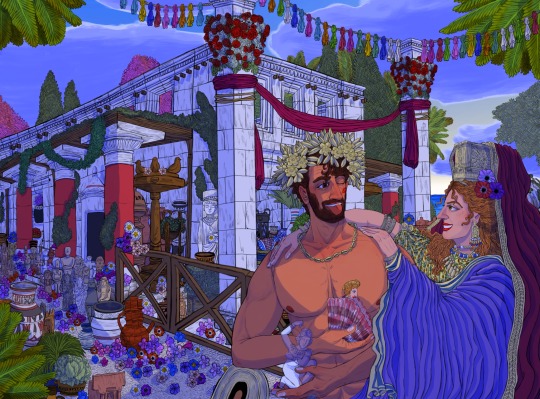
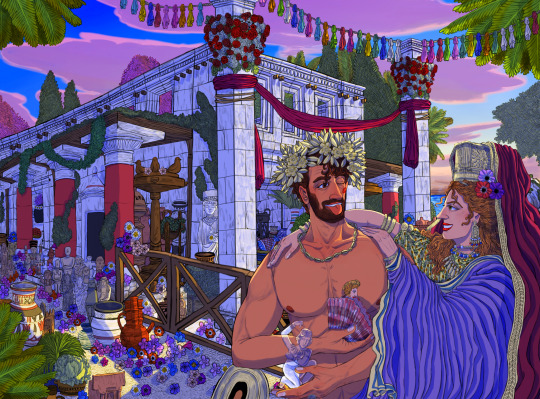
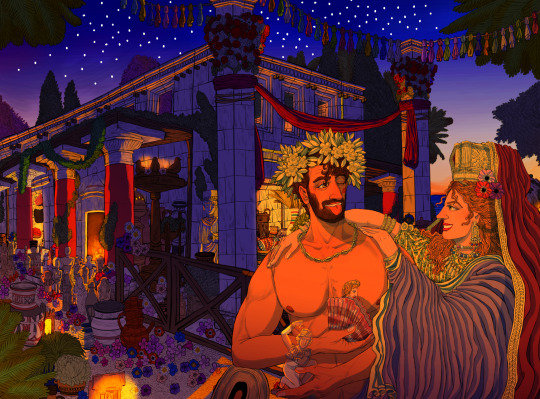
“Of Kythereia, born in Kypros, I will sing. She gives kindly gifts to men: smiles are ever on her lovely face, and lovely is the brightness that plays over it…”
Series of illustrations of Aris and Afroditi, in belated celebration of Valentine’s Day, the day of love. Behind them is one of the oldest temples dedicated to the goddess, the sacred Sanctuary of Aphrodite Paphia in Paleopaphos (Kouklia), Cyprus. (built somewhere within the 12th century BC, around the time of the Late Bronze Age; which acted as the main sanctuary and pilgrimage site late until the late Roman times.)
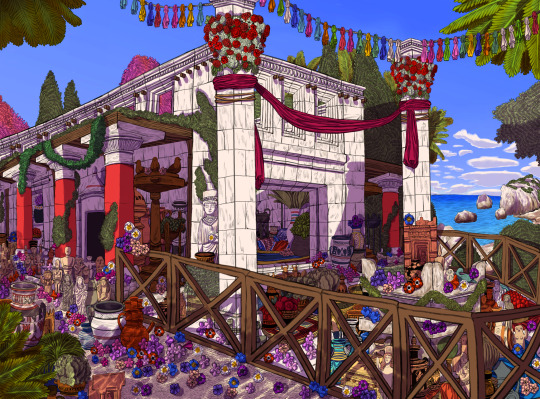
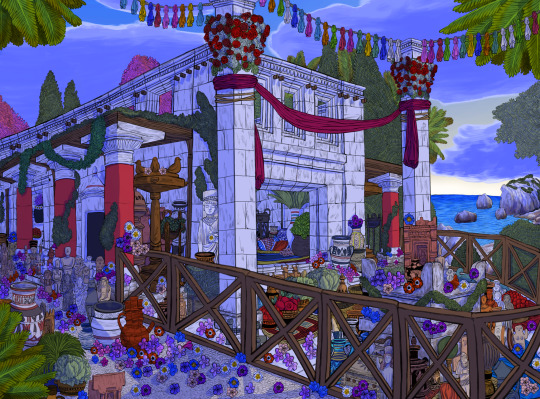
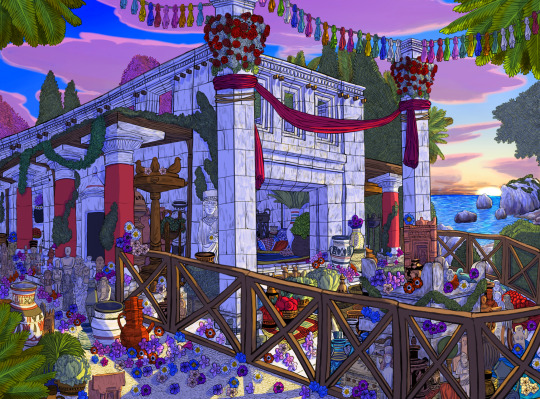
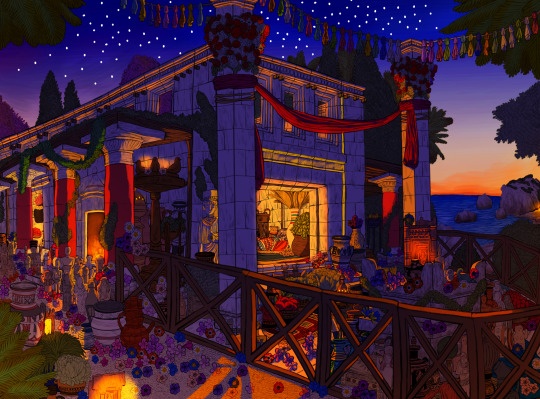
Its architectural style, depicted in the later Roman coins, didn’t really resembled to the usual well-known Greco-Roman architecture that we usually associated with “classical temples”at all, so I kind of based a lot of my interpretations & researching on other temples that found in neighboring Mycenaean Crete, Ancient Egypt and other Levantine/Upper Mesopotamian civilizations of Near East. (particularly Phoenicians, Hittites & Ugarit.)
#ancient greek#greek mythology#ares#aphrodite#ares and aphrodite#mars#venus#mars and venus#my art#trying to set the bg & the subjects (the gods themselves) in different times moods & atmospheres of the day#and has been ❤️❤️ with the color richness and playing with shadow factor of it lol
261 notes
·
View notes
Text
a lot of potential reforms of classics suggest changing the name of the discipline and i’m not against that at all in principle because the name classics is A) vague to the point of meaninglessness and B) deeply tied to imperialism + white supremacy but i feel like none of the alternatives i’ve seen suggested are Great.
i’ve seen something along the lines of “greek and roman studies” suggested a couple times but it doesn’t feel right to me (even aside from the fact that calling it greek studies implies an extension into modern greece as well, which would envelop a whole separate field of study) because it still limits the field’s area of interest to “(ancient) greece” and “rome”, but the attempt to divide those from their surroundings and elevate them (creating a “greco-roman world”) is part of the problem in and of itself. what do we define as the extent of greece? of rome? what about disciplines that are interconnected with both areas and are often included under the umbrella of classics, like phoenician/punic studies or egyptology? those aren’t greek or roman but they’re taught in classics departments, so what happens to them? i feel like the whole point should be that classics aren’t just “greece” and “rome”! renaming it that defeats the purpose!
#idk im just musing. but i think the discipline has to continue being opened beyond ‘greece’ and ‘rome’#because they ARENT exceptional and they ARENT separate from the world and the other cultures around them#thats the point baby!!!!#ribbits
96 notes
·
View notes
Note
Top 5 (archaeological) places in sicily!
oh I love this question! also appreciate the specificity because if it was my top 5 generic places in Sicily I'd be here all night
Valle dei Templi in Agrigento, which is as basic a choice as it is iconic ❤️
the greco-roman theatre of Taormina! 10/10 always gives me existential crises about history and human life
the island settlement of Motya, the first archaeological site I ever visited that wasn't greek or roman, and which cemented my love and obsession with the phoenicians
the greek theatre of Catania, not for the original structure itself so much as for the way it's been built on and integrated within the structure of the modern buildings
the Addaura caves, an amazing cave painting complex from the mesolithic age in the area of Palermo!
#nothing from messina here because we have no archaeological sites here they're all destroyed#they're there but they're in the museum and they're mostly medieval 😔
16 notes
·
View notes
Text
Name Generator
So for the past few months, I’ve been using Fantasy Name Generator for new characters. Right now, I’m seriously wishing I’d been doing it the whole time I’ve been writing my novel and part of me wants to go back and change the names of nearly all of my characters. Not only does the generator have random names for elves, goblins, dwarves, dragons, and other fantasy creatures, they also have a pretty okay selection of real-world and historical names.
In First Empress for example, I’ve been generating Gaul names for new Gannic characters and Phoenician names for the Venarri, since they’re largely based on those cultures. Queen Viarra’s native people, the Tollesians, meanwhile, are more Greco/Roman flavored, but looking through the name generator, I felt like Etruscan names fit better with the existing Tollesain names, so I’ve been using it instead.
Meanwhile, I’ve also added an Achaemenid-flavored people called the Artila to the story. Unfortunately the name generator doesn’t have an Achaemenid Persian, Sassanid Persian, or even Parthian list---just a modern Persian/Iranian generator. Instead I’ve been going with Hittite names. My two newest characters are Amalu, an Artilan warrior king-regent and Turla, his warrior-princess niece. They’re minor characters right now, but I plan for them to be important allies to Queen Viarra later in the story.
29 notes
·
View notes
Photo
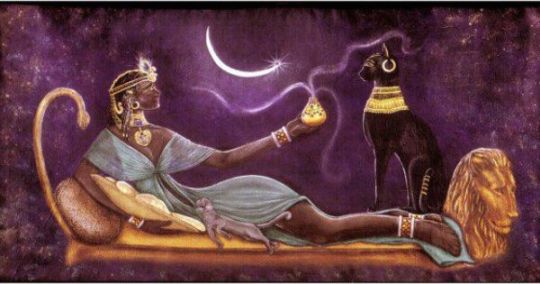
A escolha desse tema aconteceu de forma interessante, eu não sou aquelas pessoas que são fissuradas em perfumes, apesar de amar sentir cheiros bons e fortes e todo dia passar perfume nos meus altares. Mas não sou exigente quanto a isso, para mim o perfume tem uma ligação muito mais emocional com momentos da minha vida. E claro, a magia de glamour com perfumes é maravilhosa. Só que lendo sobre os arquétipos de Bast, notei sua ligação com os perfumes e achei uma ótima oportunidade de aprender mais sobre essa relação a qual eu sei bem pouco. Assim como entender melhor o que os keméticos (antigos egípcios) achavam dos perfumes e seus usos. Espero que gostem e mantenham-se perfumados.
7 dias de culto em homenagem ao amor e ferocidade de Bast
- DIA 4 -
Bast, Kemet e os perfumes
Para a bruxaria, perfumes podem ser grandes aliados para alcançarmos os nossos objetivos. Desde magias de glamour, para suavizar relações e até para agradar a deuses, os perfumes vem envolvendo a vida magística. E para além disso, envolvem a história humana, a maioria de nós já ouviu sobre a boa reputação dos perfumes franceses e dentre os povos antigos, esses líquidos de cheiros variados feitos através de longos processos de extração de plantas, podiam ter um papel importante.
A primeira forma de perfume foi o incenso que surgiu na Mesopotâmia há mais ou menos 4000 anos. Os antigos queimavam resinas e madeira em seus rituais com diversos objetivos. E em Kemet (Egito) o incenso chegou por volta de 3000 antes da Era Comum e os perfumes só foram usados estritamente em rituais religiosos até o início da Idade de Ouro. Provavelmente eles se tornaram acessíveis a outras camadas sociais à medida que os sacerdotes liberavam, com o tempo, os cidadãos tomavam banhos elaborados e embebiam a pele em óleos perfumados por prazer. Os antigos egípcios foram os primeiros a capitalizar os perfumes na imagem em garrafas que conhecemos até hoje, os recipientes da época eram feitos de pedra de alabastro e decorados com designs próprios. Dizem até que Cleópatra cumprimentou Marco Antônio em um barco com velas perfumadas após o assassinato de Júlio César.
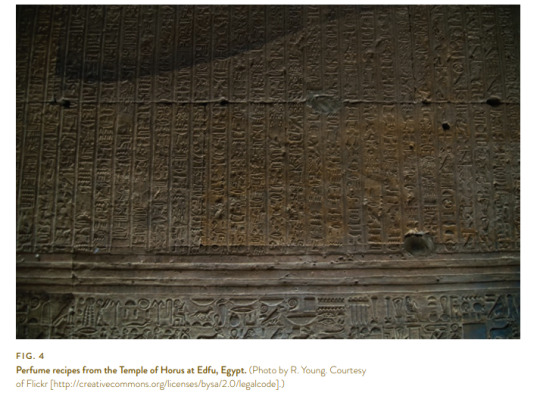
Mas o que Bast tem de relação com os perfumes? Bom, a deusa Bastet está relacionada ao perfume porque Ela é a deusa do “bas” ou frasco de perfume. Arqueólogos acreditam que seu nome significa “ela do frasco de perfume”, já que nos hieróglifos a palavra “bas” é escrita usando a imagem de um frasco de perfume. Esses potes eram pesados, muitas vezes cheios de perfumes caros que eram valiosos em Kemet, considerando a própria necessidade daquele povo de maquiagem, banho e higiene e também pelo tempo quente que poderia influenciar o uso constante de perfumes, unguentos e óleos.
A pesquisadora Barbara Watterson, famosa pela escrita dos livros “Women in Ancient Egypt” e “Gods of Ancient Egypt” acredita que é provável que o fetiche originalmente adorado em Per-Bast (Bubastis) assemelhava-se ao jarro de perfume. Joann Fletcher, importante egiptóloga, afirma que além do frasco de perfume se referir a pureza do ritual de culto à Bast, essa deusa em algumas versões era mãe de Nefertem, deus lótus onde o sol nasce relacionado aos perfumes e a alquimia, então Bast seria literalmente o vaso que carregava o lótus. Outros pesquisadores asseguram que a deusa Bastet agiu exatamente como um unguento ou óleo perfumado contidos em frascos como meio de proteção, o que se conecta com os arquétipos iniciais de Bast enquanto deusa da proteção de locais sagrados, áreas reais e nas batalhas.
O alabastro-calcita, material dos recipientes de perfumes é considerada a pedra de Bast e é um material notável pela pureza, alvura e transparência, se transformando em recipiente útil e importante para medicamentos e substâncias relacionadas com os deuses. O alabastro era usado principalmente para proteção de perfumes, remédios e outros conteúdos contra agentes externos. É interessante notar que na época de grande comercialização de perfumes, existia uma relação intensa de comércio desses produtos entre os fenícios (considerados os melhores perfumistas do mediterrâneo) e os habitantes de Per-Bast.
A relação comercial entre os fenícios e Per-Bast provavelmente ocorreu a partir da Idade do Ferro. A cidade de Bastet ficava no leste do delta do Nilo que tinha um ponto de carregamento de produtos vindos do Mar Vermelho. E os fenícios também tinha adoração à deusa Bast, hipoteticamente devido ao comércio lucrativo de perfumes e aromas. O estudo dos nomes próprios semitas de todos os gêneros e origens mostra que muitos nomes relacionados a indivíduos que vivem em Heliópolis, alguns dos quais poderiam ter feito parte da comunidade fenícia local envolvida no transporte de mercadorias (e perfumes), possuem provável relação com Per-Bast, seriam alguns dos nomes: Ahoubasti, Baal-Bastet e Abd'abst.
Refletindo sobre as relações entre os perfumes e o culto à Bast, acredito que possamos trazer essas conexões para o nosso culto moderno. Oferecermos e consagrarmos óleos, unguentos e perfumes para essa divindade é uma forma muito bonita de conexão. Podemos fazer óleos para a proteção e pedir para que Bast os abençoe e aja como o próprio líquido nos espaços e pessoas que quisermos proteger. Ou simplesmente queimar essências que Ela goste ou borrifar perfume nos espaços sagrados em que Ela se encontra, as possibilidades são inúmeras.
DUA BAST!
Autora: Appalachia (Iohara Quirino)
Referências
- “Perfumes, aromatics, and purple dye: phoenician trade and production in the greco-roman period” por Dina Frangié-joly.
- “Alexandria, an emporium in the silk road, and the traffic of unusual medicines” por Ana Maria Rosso.
- “The essence and use of perfume in ancient Egypt” Sheila Ann Byl.
- “Bast, perfumed protector, cat goddess” por Caroline Seawright.
- “The story of perfume” por McGill office for science and society.
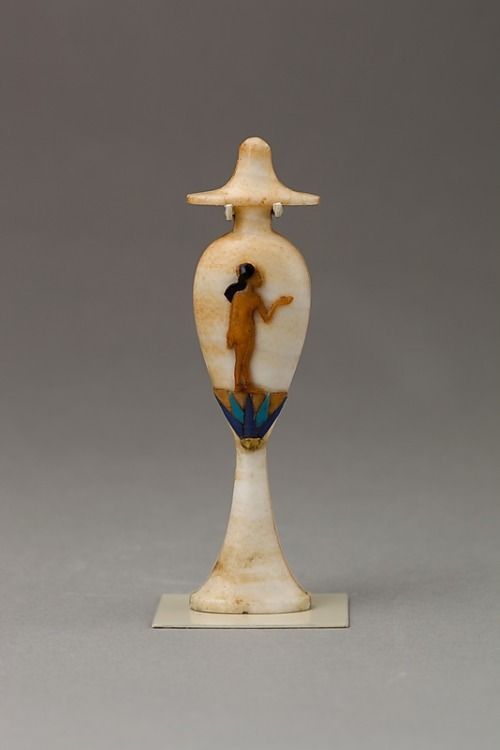
#goddess#bastet#bast#cat#egypt#perfumes#perfumes no egito#texts kemet#deusa#deusa bastet#deusa bast#fenícios#alabastro#comércio de perfumes#essências#óleos#unguentos
17 notes
·
View notes